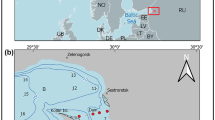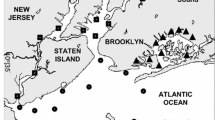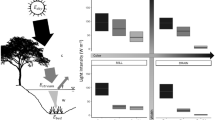Abstract
Light attenuation in marine ecosystems can limit primary production and determine the species composition and abundance of primary producers. In Florida Bay, the importance of understanding the present light environment has heightened as major upstream water management restoration projects have been proposed and some are already being implemented. We analyzed a 2-yr (2001–2003) data set of the light attenuation coefficient (Kt) and its principal components (water, chromophoric dissolved organic matter [CDOM], tripton, phytoplankton) obtained at 40 stations within Florida Bay, calibrated synoptic underway data to produce high spatial resolution maps, examined the potential for light limitation, and quantified the individual effect of each component upon light attenuation. Tripton was the dominant component controlling light attenuation throughout Florida Bay, whereas the contribution of chlorophylla and CDOM to Kt was much smaller in all regions of Florida Bay. It was possible to accurately estimate the light attenuation coefficient from component concentrations, using either a mechanistic or a statistical model with root mean square errors of 0.252 or 0.193 m−1, respectively. Compared to other estuaries, Florida Bay had the lowest overall Kt and the greatest relative contribution from tripton. Comparing the recent data to a study of Florida Bay’s light environment conducted in 1993–1994, we found that overall water clarity in the Bay increased significantly, indicated by a nearly 3-fold decrease in Kv as a result of lower tripton concentrations, although the percent contribution of each of the components to Kt is unchanged. Only the northwest corner of Florida Bay, an area comprised of approximately 8% of the Bay’s total area, was found on average to have sufficient light attenuation to limit the growth of seagrasses. This is much less extensive than in 1993–1994, when seagrass growth was potentially limited by light at over 50% of the stations sampled.
Similar content being viewed by others
Literature Cited
Atlas, D. andT. T. Bannister. 1980. Dependence of mean spectral extinction coefficient of phytoplankton on depth, water color, and species.Limnology and Oceanography 25:157–159.
Bannister, T. T. 1974. A general theory of steady state phytoplankton growth in a nutrient saturated mixed layer.Limnology and Oceanography 19:13–30.
Boyer, J. N., J. W. Fourqurean, andR. D. Jones. 1997. Spatial characterization of water quality in Florida Bay and Whitewater Bay by multivariate analyses: Zones of similar influence.Estuaries 20:743–758.
Boyer, J. N., J. W. Fourqurean, andR. D. Jones. 1999. Seasonal and long-term trends in the water quality of Florida Bay (1989–1997).Estuaries 22:417–430.
Butler, M. J., J. H. Hunt, W. F. Hernkind, M. J. Childress, R. Bertelsen, W. Sharp, T. Matthews, J. M. Field, andM. G. Marshall. 1995. Cascading disturbances in Florida Bay, USA: Cyanobacteria blooms, sponge mortality, and implications for juvenile spiny lobsters,Panulirus argus.Marine Ecology Progress Series 129:119–125.
Christian, D. andY. P. Sheng. 2003. Relative influence of various water quality parameters on light attenuation in Indian River Lagoon.Estuarine Coastal and Shelf Science 57:961–971.
Clark, C. D., J. Jimenez-Morais, G. Jones, E. Zanardi-Lamardo, C. A. Moore, andR. G. Zika. 2002. A time-resolved fluorescence study of dissolved organic matter in a riverine to marine transition zone.Marine Chemistry 78:121–135.
Cloern, J. E. 1987. Turbidity as a control on phytoplankton biomass and productivity in estuaries.Continental Shelf Research 7:1367–1381.
Dortch, M. S., C. F. Cerco, A. M. Teeter, andR. T. McAdory. 1997. Work Plan for a Water Quality Model of Florida Bay. Army Corps of Engineers, U.S. Army Engineer District Jacksonville, Florida
Duarte, C. M. 1991. Seagrass depth limits.Aquatic Botany 40:363–377.
Everglades Forever Act (EFA). 1994. Florida Statute 373.4592. Florida State Legislature, Tallahassec, Florida.
Florida Forever Act (FFA). 2000. Florida Statute 259.105. Florida State Legislature, Tallahassee, Florida.
Fonseca, M. S. 1989. Sediment stabilization byHalophila decipiens in comparison to other seagrasses.Estuarine Coastal and Shelf Science 29:501–507.
Fourqurean, J. W. andM. B. Robblee. 1999. Florida Bay: A history of recent ecological changes.Estuaries 22:335–357.
Fourqurean, J. W., A. Willsie, C. D. Rose, andL. M. Rutten. 2001. Spatial and temporal pattern in seagrass community composition and productivity in south Florida.Marine Biology 138:341–354.
Gallegos, C. L. 2001. Calculating optical water quality targets to restore and protect submersed aquatic vegetation: Overcoming problems in partitioning the diffuse attenuation coefficient for photosynthetically active radiation.Estuaries 24:381–397.
Gordon, H. R. andA. Y. Morel. 1983. Remote Assessment of Ocean Colour for Interpretation of Satellite Visible Imagery, A Review. Springer, New York.
Hansen, M. and N. T. Dewitt. 2000. 1890 and 1990 Bathymetry of Florida Bay. United States Geological Survey open-file report #00-374. St. Petersburg, Florida.
Hoge, F. E., A. Vodacek, andN. V. Blough. 1993. Inherent optical properties of the ocean: Retrieval of the absorption coefficient of chromophoric dissolved organic matter from fluorescence measurements.Limnology and Oceanography 38:1394–1402.
Hunt, J. H. In Press.A Synthesis of Research on Florida Bay. Technical Report ###. Florida Fish and Wildlife Research Institute, St. Petersburg, Florida.
Kenworthy, W. J. andM. S. Fonseca. 1996. Light requirements of seagrassesHalodule wrightii andSyringodium filiforme derived from the relationship between diffuse light attenuation and maximum depth distribution.Estuaries 19:740–750.
Kirk, J. T. O. 1980. Spectral absorption properties of natural waters: Contribution of soluble and particulate fractions to light absorption in some inland waters of southeastern Australia.Australian Journal of Marine and Freshwater Research 31:287–296.
Kirk, J. T. O. 1994. Light and Photosynthesis in Aquatic Ecosystems, 2nd edition. Cambridge University Press, Cambridge, U.K.
Lawrence, D., M. J. Dagg, H. Liu, S. R. Cummings, P. B. Ortner, andC. R. Kelble. 2004. Wind events and benthic-pelagic coupling in a shallow subtropical bay in Florida.Marine Ecology Progress Series 266:1–13.
Lorenzen, C. J. 1972. Extinction of light in the ocean by phytoplankton.Journal du Conseil 34:262–267.
McKee, D., A. Cunningham, andK. Jones. 1999. Simultaneous measurements of fluorescence and beam attenuation: Instrument characterization and interpretation of signals from stratified coastal waters.Estuarine Coastal and Shelf Science 48:51–58.
McPherson, B. F. andR. L. Miller. 1987. The vertical attenuation of light in Charlotte Harbor, a shallow, subtropical estuary, south-western Florida.Estuarine Coastal and Shelf Science 25:721–737.
McPherson, B. F. andR. L. Miller. 1994. Causes of light attenuation in Tampa Bay and Charlotte Harbor, Southwestern Florida.Water Resources Bulletin 30:43–53.
Moore, C. A., C. T. Farmer, andR. G. Zika. 1993. Influence of the Orinoco River on hydrogen peroxide distribution and production in the eastern Caribbean.Journal of Geophysical Research 98:2289–2299.
Nuttle, W. K., J. W. Fourqurean, B. J. Cosby, J. C. Zieman, andM. B. Robblee. 2000. The influence of net freshwater supply on salinity in Florida Bay.Water Resources Research 36:1805–1822.
Parsons, T. R. 1961. On the pigment composition of eleven species of marine phytoplankters.Journal of the Fisheries Research Board of Canada 18:1017–1025.
Phlips, E. J. andS. Badylak. 1996. Spatial variability in phytoplankton standing stock and composition in a shallow inner-shelf lagoon, Florida Bay, Florida.Bulletin of Marine Science 58:203–216.
Phlips, E. J., S. Badylak, andT. C. Lynch. 1999. Blooms of the picoplanktonic cyanobacterium synechococcus in Florida Bay, a subtropical inner-shelf lagoon.Limnology and Oceanography 44:1166–1175.
Phlips, E. J., T. C. Lynch, andS. Badylak. 1995. Chlorophylla, tripton, color, and light availability in a shallow tropical innershelf lagoon, Florida Bay, USA.Marine Ecology Progress Series 127:223–234.
Robblee, M. B., T. R. Barber, P. R. Carlson, M. J. Durako, J. W. Fourquerean, L. K. Muehlstein, D. Porter, L. A. Yarbro, R. T. Zieman, andJ. C. Zieman. 1991. Mass mortality of the tropical seagrassThalassia testudinum in Florida Bay (USA).Marine Ecology Progress Series 71:297–299.
Shoaf, W. T. andB. W. Lium. 1976. Improved extraction of chlorophylla andb from algae using dimethyl sulfoxide.Limnology and Oceanography 21:926–928.
Smith, N. P. 1997. An introduction to the tides of Florida Bay.Florida Scientist 60:53–67.
Stedmon, C. A., S. Markager, andH. Kaas. 2000. Optical properties and signatures of chromophoric dissolved organic matter (CDOM) in Danish coastal waters.Estuarine Coastal and Shelf Science 51:267–278.
Sverdrup, H. U., M. W. Johnson, andR. H. Fleming. 1954. The Oceans: Their Physics, Chemistry, and General Biology. Prentice Hall, Englewood Hills, New Jersey.
Tilmant, J. T. 1989. A history and an overview of recent trends in the fisheries of Florida Bay.Bulletin of Marine Science 44:3–22.
Turney, W. J. andB. F. Perkins. 1972. Molluscan distribution in Florida Bay. Sedimenta III. Report; University of Miami, Miami, Florida.
Vant, W. N. 1990. Causes of light attenuation in nine New Zealand estuaries.Estuarine Coastal and Shelf Science 31:125–137.
Wang, J. D., J. Van De Kreeke, N. Krishnan, andD. Smith. 1994. Wind and tide response in Florida Bay.Bulletin of Marine Science 54:579–601.
Wanless, H. R. andM. G. Tagett. 1989. Origin, growth, and evolution of carbonate mud-banks in Florida Bay.Bulletin of Marine Science 44:454–489.
Water Resources Development Act (WRDA). 2000. Public Law 106-541 Title VI, section 601. Government Publishing Office, Washington, D.C.
Young, R. A., T. L. Clarke, R. Mann, andD. J. P. Swift. 1981. Temporal variability of suspended particulate concentrations in New York Bight.Journal of Sedimentology and Petrology 51:293–306.
Zieman, J. C., J. W. Fourqurean, andT. A. Frankovich. 1999. Seagrass die-off in Florida Bay: Long-term trends in abundance and growth of turtle grass,Thalassia testudinum.Estuaries 22:460–470.
Zieman, J. C., J. W. Fourqurean, andR. L. Iverson. 1989. Distribution, abundance, and productivity of seagrasses and macroalgae in Florida Bay.Bulletin of Marine Science 44:292–311.
Author information
Authors and Affiliations
Corresponding author
Rights and permissions
About this article
Cite this article
Kelble, C.R., Ortner, P.B., Hitchcock, G.L. et al. Attenuation of photosynthetically available radiation (PAR) in Florida Bay: Potential for light limitation of primary producers. Estuaries 28, 560–571 (2005). https://doi.org/10.1007/BF02696067
Received:
Revised:
Accepted:
Issue Date:
DOI: https://doi.org/10.1007/BF02696067




